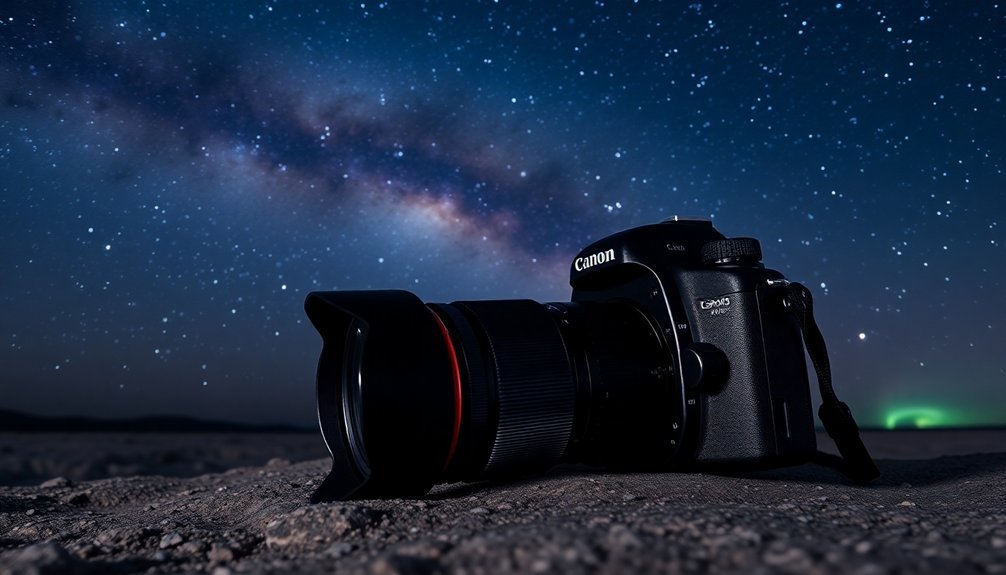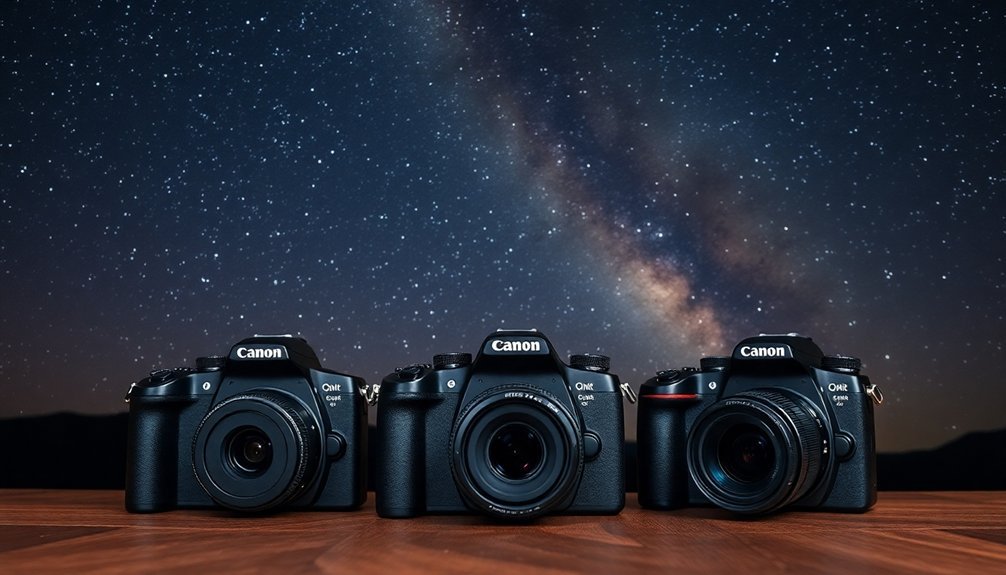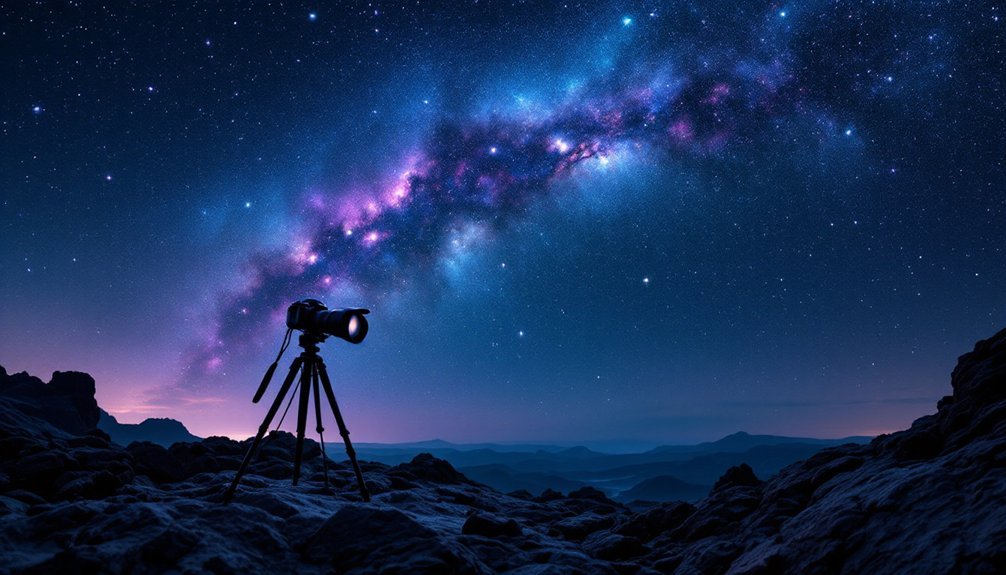For beginner space photography, you'll find excellent value in the Canon Rebel series (T7, T6i) or Nikon D3500, with used models starting around $250. These entry-level DSLRs offer essential manual controls, Live View focusing, and compatibility with telescope adapters. You'll want to pair your camera with a wide-angle lens like the Rokinon 14mm f/2.8 for stunning night sky shots. Understanding key features and accessories will transform your celestial photography journey.
Why DSLRs Excel for Space Photography

While many camera types can capture the night sky, DSLRs stand out as exceptional tools for space photography thanks to their versatile features and robust design.
You'll benefit from their large sensors that excel in low-light conditions, making it easier to capture faint stars and distant galaxies.
Large sensors are the night photographer's secret weapon, capturing the faintest celestial objects that other cameras might miss entirely.
The interchangeable lens system lets you adapt to different celestial subjects, from wide-angle Milky Way shots to detailed moon photography.
You'll appreciate the optical viewfinder for direct scene composition and the Live View feature for precise focusing on stars.
What's more, DSLRs' ergonomic design and durable build hold up well during long nights of shooting outdoors.
Whether you're stacking multiple exposures or tracking moving objects, DSLRs provide the flexibility and reliability you need to start your space photography journey. You can find quality used DSLR models for as little as $250, making them a cost-effective entry point into astrophotography.
Top Budget-Friendly DSLR Models for Night Sky Shooting
You'll find Canon's Rebel series provides excellent entry points for space photography, with the T7 and T6i offering great value while maintaining essential features for night sky shooting.
For those considering Nikon, the D3500 stands out as a particularly wallet-friendly option that doesn't compromise on image quality or ease of use.
Both manufacturers' budget models support the vital functions you'll need for astrophotography, including manual controls and compatibility with telescope adapters. These entry-level cameras can produce stunning results when paired with a wide-field refractor telescope.
Entry-Level Canon Choices
Three standout Canon DSLR models make excellent choices for beginner astrophotographers: the Rebel T7, T6i, and SL3.
The T7 offers great value with its 18MP sensor and Wi-Fi connectivity, making it easy to transfer your night sky images. If you're looking for higher resolution, the T6i's 24.2MP sensor delivers sharper details of celestial objects.
The SL3 stands out as the most versatile option, combining a lightweight design with 4K video capabilities. With its fully articulated touchscreen, you can comfortably frame and capture night sky shots from challenging angles.
All three cameras feature APS-C sensors that work well in low-light conditions and offer ISO ranges suitable for night photography. You'll appreciate their compatibility with wide-angle lenses and telescopic adapters, essential for capturing different types of astronomical subjects.
These models also include helpful features like Live View and built-in sensor cleaning.
Affordable Nikon Offerings
Nikon's lineup of budget-friendly DSLRs presents compelling options for aspiring astrophotographers.
You'll find excellent value in the D3500, which offers reliable battery life and user-friendly controls perfect for learning night photography basics. Using PhotoPills for planning your night shoots can significantly improve your results with this camera.
If you're seeking more advanced features, consider the D5600 with its articulating touchscreen or the D7500 with superior build quality.
For those ready to invest in full-frame capabilities, the D750 and D610 deliver outstanding low-light performance at reasonable price points.
These cameras pair well with affordable wide-angle lenses like the Rokinon 14mm f/2.8 or Tokina 11-16mm f/2.8, giving you the essential tools for capturing stunning night sky images.
Essential DSLR Features for Capturing the Cosmos

Selecting the right DSLR for space photography requires understanding key features that make capturing the cosmos possible.
You'll need a camera with a full-frame sensor to maximize light capture and strong ISO performance to manage noise in dark conditions.
Look for a DSLR that offers manual mode control, as you'll be adjusting exposure settings frequently.
Wide aperture capabilities and long exposure features are essential for capturing faint celestial objects.
Your camera should also have reliable Live View functionality with zoom capability for precise focusing on stars and planets.
Consider a model that includes a built-in intervalometer feature for capturing night sky movement at regular intervals.
Make sure your chosen DSLR supports interchangeable lenses and has computer connectivity for image processing.
Don't forget about storage capacity – you'll need plenty of space for multiple exposures when stacking images to create detailed astronomical photos.
How to Choose Your First Astrophotography DSLR
When selecting your first astrophotography DSLR, you'll need to weigh your available budget against must-have features like good ISO performance and manual controls.
You'll find entry-level Canon and Nikon models offer excellent value, especially when purchased used, while still providing the essential specs needed for capturing deep sky objects.
Your camera choice should also account for lens compatibility, as you'll likely want to experiment with different focal lengths as your skills progress. Consider that a DSLR's larger sensor size provides superior light-gathering ability compared to smaller sensor cameras.
Budget vs. Features Balance
Finding the sweet spot between budget and features presents one of the biggest challenges for aspiring astrophotographers.
You'll want to focus on essential features like Live View capability and manual exposure controls without breaking the bank.
For most beginners, a crop-sensor DSLR in the $500-$1,000 range offers the best value.
Consider the Canon Rebel series or Nikon D5300, which provide excellent starting points. Higher megapixels in newer models can actually increase noise in night sky photos.
While full-frame cameras excel at wide-field shots, crop-sensors work better with telescopes and cost less.
Don't forget to factor in essential accessories.
You'll need a tracking mount and proper lenses, which can greatly impact your total investment.
If you're looking to save money, the used market offers excellent opportunities, especially for higher-end models that would otherwise be out of reach.
Essential Camera Specs
Five essential camera specifications will determine your success in astrophotography: ISO range, sensor size, shutter modes, raw format capability, and live view functionality.
You'll need higher ISOs for low-light capture, though this introduces noise. While full-frame sensors offer better light sensitivity, crop sensors work well for beginners and telescope-mounted photography. Used models with T-rings and adapters are necessary when connecting your camera to a telescope.
- Choose a camera with manual and bulb modes for complete exposure control.
- Look for models offering raw format capture to maximize post-processing potential.
- Confirm your camera has live view with a flip-out screen for easier focusing.
Modern entry-level DSLRs like the Canon EOS Rebel T7 or Nikon D3400 provide these essential features at reasonable prices.
If your budget allows, consider the Canon EOS 6D Mark II for enhanced performance or specialized models like the Canon EOS Ra for dedicated astrophotography.
Lens Compatibility Options
Beyond the camera body itself, your choice of lenses will shape your astrophotography journey. For Canon and Nikon DSLRs, you'll find extensive lens options through both native and third-party manufacturers like Rokinon and Sigma.
Start with a wide-angle lens in the 10-35mm range with an aperture of f/2.8 or wider. The Rokinon 14mm f/2.8 offers excellent value for beginners, while the Sigma 14-24mm f/2.8 provides premium quality if you're willing to invest more.
For specific constellation shots, consider fast prime lenses like the affordable Canon 50mm f/1.8 STM. When shooting during less-than-ideal conditions, the nifty fifty remains a reliable choice for capturing detailed night sky images.
Must-Have Accessories for DSLR Space Photography
While a DSLR camera forms the foundation of astrophotography, you'll need several essential accessories to capture stunning images of the night sky. Your success depends on having the right tools to mount, track, and power your equipment during long exposure sessions.
- Start with a T-ring adapter to connect your camera to the telescope, and consider adding a field flattener or coma corrector based on your telescope type.
- Invest in a reliable equatorial mount or portable star tracker to follow celestial objects as Earth rotates.
- Don't forget power management – you'll need portable batteries and controllers to keep your gear running through the night.
A Bahtinov mask will help you achieve perfect focus, while dew heaters and red headlamps will protect your equipment and preserve your night vision. A sturdy tripod is absolutely essential for achieving sharp, stable shots during long exposures of the night sky.
Setting Up Your DSLR for Night Sky Success

Successful night sky photography requires precise DSLR setup to capture the cosmos in stunning detail.
You'll need to switch your camera to manual mode for complete control and mount it securely on a tripod to prevent unwanted movement. A secure mounting plate will ensure your camera stays firmly attached throughout long exposures. Set your aperture to f/4 or lower to maximize light gathering capabilities.
Manual focus is essential for sharp star images – use your camera's live-view zoom feature to focus on a bright star. Set your exposure time between 15 and 30 seconds, and choose an ISO between 400 and 1600 to capture the night sky's detail.
Don't forget to set your white balance to daylight for consistent colors. By shooting in RAW format, you'll have greater flexibility during post-processing.
Monitor your histogram throughout the shoot to guarantee ideal exposure levels.
Common Challenges and Solutions in DSLR Space Photography
Even with perfect camera settings, DSLR space photography presents several key challenges that can test your patience and skill.
Deep-sky objects are often too dim to see in live view, making framing and focusing particularly tricky. You'll need a reliable finder scope or plate-solving software to accurately target these elusive objects. Advanced photographers often use the Bahtinov mask technique for achieving precise focus on celestial objects.
Here are three critical challenges you'll face and how to overcome them:
- Focus accuracy – Use a bright star nearby and a focus mask to achieve sharp images.
- Equipment stability – Invest in a solid tracking mount and tripod to prevent star trails.
- Light pollution – Plan your shoots during clear nights and use post-processing software to enhance contrast.
Don't get discouraged by these obstacles – with proper preparation and the right tools, you'll be capturing stunning space photos in no time.
Comparing Entry-Level DSLRs for Star Photography

Three standout DSLR cameras have emerged as top choices for beginner astrophotographers: the Canon EOS Rebel T7, Nikon D3400, and Canon EOS 80D. Each offers unique advantages for capturing the night sky.
The Rebel T7 balances affordability with essential features, making it ideal if you're just starting out. Be wary of purchasing the camera as part of all-purpose bundles that include low-quality accessories marketed to beginners.
The Nikon D3400 shines with its user-friendly interface and versatility, while the EOS 80D steps up with superior image quality and a handy tilt LCD screen.
When comparing these models, you'll find Canon emphasizes ease of use, while Nikon excels in autofocus capabilities.
The EOS 80D's broader dynamic range captures more celestial detail, but the D3400's simplicity might better suit absolute beginners.
Consider your budget and skill level – you can't go wrong with any of these proven performers.
Upgrading Your DSLR Space Photography Skills
Once you've mastered the basics of DSLR astrophotography, upgrading your skills requires a strategic combination of equipment enhancements and technical knowledge.
Start by upgrading your mount with a reliable tracking system and guide scope to capture longer exposures. You'll also want to shoot in RAW format with manual settings, keeping your ISO between 500-1600 for best results. Give your eyes 20-30 minutes to adapt before beginning your photography session.
- Invest in quality processing software and learn stacking techniques to improve signal-to-noise ratio.
- Practice capturing calibration frames (bias, dark, flat) to eliminate unwanted artifacts.
- Experiment with different celestial targets, from star trails to deep-sky objects.
Consider joining astrophotography communities to learn from experienced photographers and use astronomy apps to plan your sessions.
Remember to choose locations with minimal light pollution for the clearest possible images.
Frequently Asked Questions
Can I Use My Old Film Camera Lenses for Astrophotography?
Yes, you can use old film lenses for astrophotography with the right adapter. You'll need to focus manually, but many vintage lenses offer wide apertures and good optical quality for night sky photography.
How Long Do DSLR Sensors Typically Last When Used for Night Photography?
Your DSLR sensor can last 7-10 years with proper care, even with night photography. It's rated for 100,000-200,000 shutter actuations, but environmental factors and maintenance will ultimately determine its lifespan.
Should I Remove the Internal IR Filter for Better Space Photography?
Don't remove your IR filter as a beginner. While it improves H-alpha light capture, you'll limit everyday photography and risk damaging your camera. Instead, try using external filters for similar results.
What Temperature Is Too Cold to Safely Operate a DSLR Outdoors?
You shouldn't operate your DSLR below -20°F (-29°C), as it can damage camera seals and mechanisms. While most DSLRs work fine between 32°F and 105°F, you'll need extra battery power in cold conditions.
Can Humidity Damage My DSLR During Overnight Astrophotography Sessions?
Yes, high humidity can seriously damage your DSLR during overnight sessions. You'll need to protect against condensation using desiccant packs, monitor dew points, and keep equipment in insulated cases to prevent moisture damage.
In Summary
You'll find that starting your space photography journey with the right DSLR makes all the difference. Whether you choose the Canon Rebel series, Nikon D3500, or another beginner-friendly model, remember to focus on low-light performance and manual controls. With proper accessories, settings, and practice, you'll soon be capturing stunning images of stars, planets, and deep-sky objects. Don't let initial challenges discourage you – the cosmos awaits your lens.





Leave a Reply